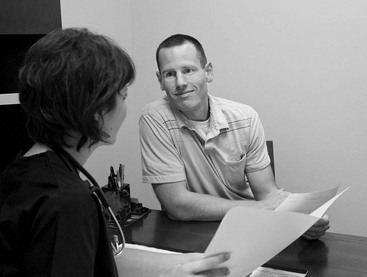CHAPTER 22 Functional Restoration
Description
Terminology and Subtypes
Functional restoration refers not only to a specific intervention for chronic low back pain (CLBP), but also to a wider conceptualization of the challenges facing clinicians and patients dealing with this condition. Functional restoration is based on the biopsychosocial approach to CLBP, which views pain and disability as the result of a complex and dynamic interaction among physiologic, psychological, and socioeconomic factors that can initiate, perpetuate, or exacerbate the clinical presentation.1,2 Functional restoration is a comprehensive approach that attempts to address these multiple contributing factors by combining interventions aimed at restoring not only physical function, but also behavioral health, and any other occupational or social difficulties that may develop as a result of prolonged disability due to CLBP. Many approaches to functional restoration have been developed by various specialty spine and chronic pain clinics.
The term multidisciplinary rehabilitation is often used to designate spine programs in which patients receive concurrent or coordinated care from behavioral, functional, and medical professionals (Figure 22-1). However, that term is not strictly defined. Multidisciplinary rehabilitation can also be interpreted narrowly and used to promote spine programs in which patients who fail to obtain adequate relief after physical therapy are then referred to surgery. Similarly, this term can also be used to designate a loose collaboration between surgical and nonsurgical specialists who rely mostly on injections or other invasive approaches aimed at specific anatomic structures. Only multidisciplinary rehabilitation programs using the more comprehensive biopsychosocial approach to CLBP espoused in this chapter can be designated as functional restoration.
History and Frequency of Use
Functional restoration was developed in the 1980s by the spine surgeon Tom Mayer and psychologist Robert Gatchel through their collaboration in a Dallas clinic that specialized in managing patients with complex, severe, or debilitating CLBP that was not responsive to conventional approaches. This intervention slowly gained popularity in the 1990s as clinicians and third-party payers became increasingly frustrated with the generally poor results observed after patients with CLBP received costly and invasive interventions. The emergence of functional restoration coincided with a wider adoption of the biopsychosocial model of LBP developed by the Scottish surgeon Gordon Waddell, and was well received by those looking for alternative approaches to managing CLBP.3 Research supporting the principles of functional restoration continues to grow. Researchers recently lauded this approach and indicated that “the concepts underlying functional restoration have been found to be highly relevant to patients with chronic low back pain, medical providers, and disability systems, and continue to gain acceptance and integration into the care of patients throughout the industrialized world.”4
Practitioner, Setting, and Availability
Functional restoration requires a multidisciplinary team of clinicians that may include a medical director, pain management specialist, psychologist or psychiatrist, nurse, physical therapist, and occupational therapist, although not all patients with CLBP will require separate interventions from each of those providers when receiving functional restoration (Figure 22-2 and Table 22-1).3–11 Given the number of health providers involved, effective communication among functional restoration team members is crucial (e.g., a patient’s fear of physical activity should be discussed openly to prevent it from interfering with their physical reconditioning program). This intervention is typically offered in specialty spine clinics located in larger cities and is not widely available in the United States.
TABLE 22-1 Health Care Providers Commonly Involved in Functional Restoration for Chronic Low Back Pain
| Practitioner | Role |
|---|---|
| Medical director | Most commonly a physician with a complete understanding of the biopsychosocial philosophy of interdisciplinary care and a firm background in providing medical rehabilitation for CLBP |
| Nurse | Assists the physician, follows up the procedures, and serves as a physician-extender to address patient needs |
| Occupational therapist | Involved in both the physical and vocational aspects of the patient’s rehabilitation because many patients with CLBP will not be working Addresses vocational issues such as return to work, work accommodations and training, and may serve as an advocate for the patient with insurers and/or employers |
| Pain management specialist | Provides anesthesiology services such as injections, nerve blocks, and other medical procedures related to CLBP |
| Physical therapist | Interacts with the patient on a daily basis to address any issues related to physical deconditioning, educates the patient about the physiologic bases of pain, and teaches methods of reducing the severity of pain through body mechanics and exercise pacing |
| Psychologist or psychiatrist | Plays the leading role in the day-to-day maintenance of the psychosocial aspects and status of patient care using evaluations to identify potential barriers to recovery and a patient’s psychosocial strengths and weaknesses A CBT approach can then be used to address important issues such as pain-related depression, anxiety, substance abuse, and other forms of psychopathology that may be encountered in long-standing CLBP Such a CBT approach has been found to be the most appropriate and effective modality to use in interdisciplinary programs |
CBT, cognitive behavioral therapy; CLBP, chronic low back pain.
Theory
Indication
Functional restoration is an appropriate tertiary care option for those patients with CLBP who have failed to respond to programs such as reactivation and work hardening, have not improved after surgical or other interventional methods, and have no active, objective pathophysiology requiring immediate medical or surgical care. It is well known that significant psychosocial barriers to successful recovery may develop as a patient progresses from acute to chronic pain. Although serious comorbid psychiatric disorders are often a contraindication to many interventions for CLBP, such psychopathology can be effectively managed within the context of a functional restoration program.12 The ideal CLBP patient for functional restoration is one who is motivated to learn to manage pain more effectively, is compliant with the prescribed rehabilitation regimen, and wishes to return to work and full activities of daily living. Often, there are certain “barriers to recovery,” such as secondary gain associated with perceived financial incentives for remaining disabled. However, even these secondary gain issues can be successfully dealt with in a comprehensive functional restoration program.13
Assessment
Before receiving functional restoration, patients should first be assessed for LBP using an evidence-based and goal-oriented approach focused on the patient history and neurologic examination, as discussed in Chapter 3. Additional diagnostic imaging or specific diagnostic testing is generally not required before initiating this intervention for CLBP. Certain questionnaires (e.g., Tampa Scale for Kinesiophobia, Fear Avoidance Beliefs Questionnaire) may be helpful to identify subsets of patients with CLBP who may benefit from specific interventions aimed at addressing those issues (e.g., fear avoidance training, as discussed in Chapter 7). Psychological testing is also required for functional restoration to identify coexisting conditions such as depression. An evaluation of medication use and functional capacity may also be indicated to tailor specific recommendations to address any noted deficiencies.
Efficacy
Clinical Practice Guidelines
The CPG from Belgium in 2006 found high-quality evidence that intensive multidisciplinary rehabilitation programs combining education, exercise, relaxation, behavioral, and other interventions are more effective than conventional interventions alone in patients with CLBP.14 That CPG also found moderate-quality evidence that intensive multidisciplinary biopsychosocial rehabilitation with a functional restoration approach is more effective than outpatient non-multidisciplinary rehabilitation or usual care with respect to improvements in pain for CLBP. Multidisciplinary rehabilitation programs based on biopsychosocial models for the management of CLBP were recommended.
The CPG from Europe in 2004 found moderate evidence that intensive multidisciplinary biopsychosocial rehabilitation with a functional restoration approach is more effective than outpatient non–multidisciplinary rehabilitation or usual care with respect to improvements in pain for CLBP.15 That CPG also found strong evidence to support the efficacy of intensive multidisciplinary biopsychosocial rehabilitation with a functional restoration approach with respect to improvements in pain and function for CLBP. There was no evidence comparing the efficacy of multidisciplinary biopsychosocial rehabilitation with a functional restoration approach to sham procedures for CLBP.
The CPG from the United States in 2007 found evidence to support the efficacy of functional restoration with CBT with respect to improvements in work absenteeism.16
The CPG from Italy in 2007 recommended that multidisciplinary rehabilitation should include a comprehensive diagnostic assessment and both individual CBT and back exercises when used for the management of CLBP.17
The CPG from the United Kingdom in 2009 recommended that multidisciplinary rehabilitation should include CBT, exercise, and some aspect of goal setting or problem solving for CLBP.18 That CPG also recommended multidisciplinary rehabilitation for patients who continue to have high disability or psychological distress after receiving less intensive interventions, and suggested that the more extensive multidisciplinary rehabilitation approaches were indicated for those with CLBP and a poor prognosis, whereas lower intensity approaches were indicated for those with CLBP and a good prognosis. There was insufficient evidence to determine that any one particular approach to multidisciplinary rehabilitation was superior to others for CLBP.
The CPG from the United States in 2009 found good evidence to support the efficacy of multidisciplinary rehabilitation using a CBT approach in the management of CLBP.19
Findings from the above CPGs are summarized in Table 22-2.
TABLE 22-2 Clinical Practice Guideline Recommendations on Functional Restoration for Chronic Low Back Pain
| Reference | Country | Conclusion |
|---|---|---|
| 14 | Belgium | Recommended |
| 15 | Europe | Strong evidence of efficacy |
| 16 | United States | Evidence to support efficacy |
| 17 | Italy | Recommended for use in conjunction with CBT and back exercises |
| 18 | United Kingdom | Recommended |
| 19 | United States | Good evidence to support efficacy |
CBT, cognitive behavioral therapy.
Systematic Reviews
Cochrane Collaboration
An SR was conducted in 2003 by the Cochrane Collaboration on functional restoration for acute and chronic LBP and neck pain.20 A total of 18 RCTs were identified, including 8 that examined the effects of functional restoration with a psychological component for CLBP.21–28 Three RCTs had no statistically significant differences between exercise combined with psychotherapy and self-exercise or placebo.22,25,26 In contrast, four RCTs did find that exercise combined with psychotherapy led to statistically significant treatment effects versus physical therapy alone.23,24,27,28 Results from the final RCT were unclear.21 This review concluded that functional restoration (i.e., exercise and psychotherapy approaches combined) is effective at reducing time lost from work for CLBP.20 This SR also concluded that functional restoration is not effective for those with acute LBP.20
American Pain Society and American College of Physicians
An SR was conducted in 2006 by the American Pain Society and American College of Physicians CPG committee on nonpharmacologic therapies for acute and chronic LBP.29 That review identified one SR related to functional restoration, which was the Cochrane Collaboration review mentioned earlier.20 No additional trials were identified. This SR concluded that functional restoration is effective for chronic or subacute LBP lasting longer than 4 weeks.29











